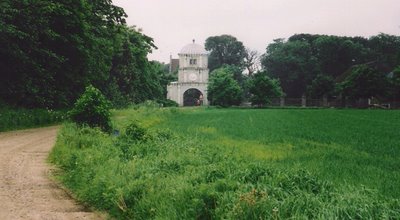
Nørre Vosborg in 2008

Nørre Vosborg in 2003

Nørre Vosborg in 2008

Nørre Vosborg in 2003
Nørre Vosborg is a successor of one of the oldest of the many fortificated borge (castles) which during the Middle Ages were established along the western coast of Jutland. Vestjylland played an important role in the Middle Ages. Its original name is Oseborg, which means borgen ved åmundingen ( by the mouth of the river) - and it is placed close to the mouth of Storåen by Ringkøbing Fjord.
Parts of it must have belonged to Erik Menved who in 1299 offered to give some of the estate to bishop Jens Grand. Later it belonged to hr. Niels Bugge and was after the assassination of him and his men in Middelfart in 1359 confiscated by Valdemar Atterdag - but after her father's death in 1375 Margrethe I gave parts of the confiscated estate back to the descendants of the murdered noblemen "for kongens sjælefreds skyld" (for the sake of the king's peace of mind).
The estate came to marsk Christiern Vendelbo who was married to Niels Bugge's daughter Ellen Nielsdatter Bugge. By inheritance and marriage the family Podebusk kept the manor until 1548 where it via Jytte Podebusk came to her husband, the former bishop Knud Gyldenstierne who was released from his celibacy after the reformation. He extended the estate with Skærumgård. Various owner up to the present.
The main building is listed in class A. The present plan is as a whole built over four centuries by various owners. It is unique with four various houses and its situation. Originally the manor was placed about 1 km south west of the earlier mouth of Storåen in Nissum fjord, where the motte is still seen, but after a destructive storm in 1532 rigsråd Predbjørn Podebusk moved the manor further into the land to its present place where he established the large motte which is protected by double water-filled moats.
Nørre Vosborg was as the first manor building in Denmark honoured with the Europa Nostra Prize, which was presented on 25 March 1982 in connection to the opening of Nørre Vosborg as a herregårdsmuseum. In the park are 1001 rhododendrons. There is a restaurant and a caféteria.
Link: Nørre Vosborg

In the park
West of the present manor in the meadow Hestehaven by Gammelåen's delta in Nissum fjord is a motte, probably the motte from the earlier Nørre Vosborg which was destroyed in 1532. According to tradition the first Nørre Vosborg must have been at an area which was swallowed by the sea and driven in poles have been found out in Nissum fjord.
Skærum/Skærumgård was possibly more than one farm and was a part of the estate which prince Buris gave to Tvis kloster. Jens Klausen with a wheel in his coat of arms is mentioned in Skærum in 1477 and 1484. After the reformation the Crown exchanged -together with Tvis Kloster - Skærum to Oluf Munk. At the farm was a chapel and a sacred well in the Middle Ages. A Romanesque font basin was there until 1920. At Tinghøj in the western part of the parish was held the herredsting (the thing of the district) for a period - and the place of execution was at the closeby Galgehøj. Later the thing was held at Ulfborg Church and from 1638 in Madum Church.
In the eastern part of the parish are several big burial mounds. A settlement from Gudenåkulturen is known by Skærum Bro (bridge). A burial site from Roman Iron Age was found at Skærum Mølle (mill) and another Iron Age burial site north of Ulfborg Stationsby. In a couple of hills north of Nørre Vosborg are burial sites from Iron Age and Viking period.

Nørre Vosborg by the old café in 2003

The cosy old café or the old restaurant have disappeared. Now is an exclusive restaurant and a modern caféteria.
photo 2003 and 2008: grethe bachmann
Ulfborg Church
The church has Romanesque choir and nave with a western tower, cross-arm, chapel and porch. The extensions are from the late Middle Ages an built in ashlars and monk bricks. A Romanesque window is preserved in the choir gable and one in each side of the nave. In the church wall is an ashlar with a male head and another with animal figures in the west portal of the church yard.
The choir and nave have beamed ceilings. The communion table is in ashlars and the Lutheranian triptychon from 1585 is equipped with a new painting. The Romanesque granite font with a Renaissance sounding board is a vestjysk (west Jutland) type. The magnificent lektorieprædikestol (pulpit) stretches across the church and is a rich Renaissance work from ab. 1587 (remade in 1599). Pretty closed Renaissance stoolsections from the beginning of the 1600s. In the western section of the nave is a gallery from 1642 with paintings. The church bell from 1457 has a minuskel-inscription (small letters). In the chapel is a large sandstone epitaph for rigsråd Preben Gyldenstierne (+1616) and his two wives. The church yard is surrounded by stone dikes with a double portal to the south and two lesser portals to the east.

The unique entrance to Nørre Vosborg
photo 7. juni 2003: grethe bachmann
No comments:
Post a Comment